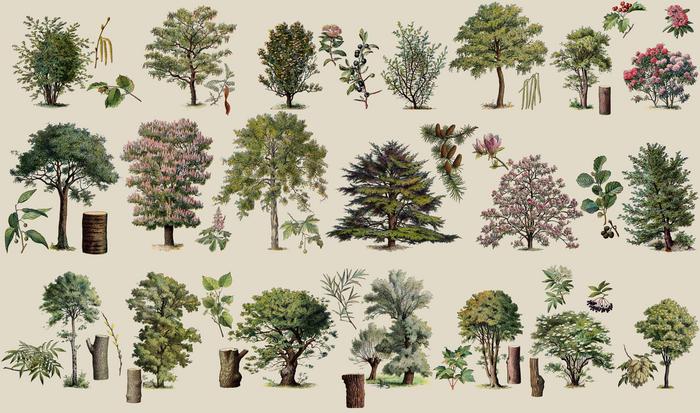When scientists and policymakers make tough calls on which areas to prioritize for conservation, biodiversity is often their top consideration. Environments with more diversity support a greater number of species and provide more ecosystem services, making them the obvious choice.

Credit: Adolphe Millot, Larousse du XXème siècle 1932
When scientists and policymakers make tough calls on which areas to prioritize for conservation, biodiversity is often their top consideration. Environments with more diversity support a greater number of species and provide more ecosystem services, making them the obvious choice.
There’s just one problem. There are several ways to measure diversity, and each reveals a slightly different, and sometimes conflicting, view of how life interacts in a forest or other ecosystem.
In a new study published in the Proceedings of the National Academy of Sciences, researchers analyzed 20-years’ worth of data, which shows that the simplest measure of diversity — namely, adding up all the species for a given area — is the best way to measure the productivity of a forest.
“There aren’t many studies that look at the differences between measurements of diversity,” said lead author Yunpeng Liu, a postdoctoral associate at the Florida Museum of Natural History. Those that have, Liu said, typically used data from small, geographically isolated forest plots.
Liu specializes in forest productivity, and when he learned the U.S. Forest Service maintains decades’ worth of tree data, he knew exactly what he wanted to do with it.
Liu and his colleagues compared how three measures of biodiversity are related to productivity, or the amount of growth, in forests across the eastern United States. They did so by analyzing nearly two million tree measurements from 23,145 forest plots. Data were collected between 2000 and 2020 from non-plantation forests, meaning the trees grew there naturally.
The team found that a greater number of tree species, called species richness, consistently resulted in a more productive forest. This isn’t all that suprising, given that the interaction between multiple species creates robust ecosystem services, such as carbon storage, wildlife habitat and resources like wood that can be harvested and regrown.
The researchers assumed that other measures of diversity would also show a strong, positive relationship with productivity. Instead, they found that the measure of relatedness (phylogenetic diversity) and of various structural and chemical differences (functional diversity) were both negatively correlated with productivity.
Phylogenetic diversity shows how closely related the species in a given environment are to each other. Healthy environments typically contain multiple species that have only a distant relationship with each other, which allows them to collectively withstand change. If a virus or fungus were to sweep through and wipe out birch trees, the overall health of the forest would benefit from having various oaks, ashes, pines, walnuts and sycamores that remained unaffected.
Similarly, functional diversity is a measure of how much variety exists in the sizes, shapes and biological processes of organisms. The more differences there are in features such as tree size, wood density and rooting depth indicates how well a forest creates and makes use of all possible resources.
“These aren’t mutually exclusive measurements,” said co-author Douglas Soltis, a distinguished professor with the Florida Museum of Natural History. “They’re all ways that we might be able to make better conservation decisions.”
Forests with higher phylogenetic and functional diversity are more resilient, but whether they’re more productive is unclear.
“We aren’t yet sure,” said co-author Robert Guralnick, curator of biodiversity informatics at the Florida Museum of Natural History.
It’s possible there isn’t enough information about traits to make an accurate assessment. This is particularly true of the shape and depth of roots, which are difficult to measure.
“It may also be that there are aspects of how trees of the same or different species structure their interactions with each other, especially as tree communities become more diverse, that we don’t yet understand,” Guralnick said.
A better understanding of diversity is indispensable for the proper management of forests and has far-reaching implications. It’s estimated that plant productivity has balanced out up to 30% of carbon emissions caused by human activity over the last several decades. Forests play a significant role in this process but are also among the most threatened ecosystems on Earth.
For now, the number of species in a forest is the best proxy for its health and productivity. It also provides an easy guide for people working to restore degraded ecosystems, allowing them to focus their efforts on planting more species.
“It’s reassuring for other investigators and policymakers to know that species richness is reliable,” Soltis said, emphasizing the comparative speed and ease with which researchers can collect and analyze this type of data compared to other measures of diversity. “This is especially important when making conservation decisions with short notice and limited data.”
J. Aaron Hogan and Jeremy Lichstein of the University of Florida, Pamela Soltis of the Florida Museum of Natural History and Samual Scheiner of the National Science Foundation are also authors on the study.
Journal
Proceedings of the National Academy of Sciences
DOI
10.1073/pnas.2314231121
Article Title
Biodiversity and productivity in eastern US forests
Article Publication Date
25-Mar-2024




